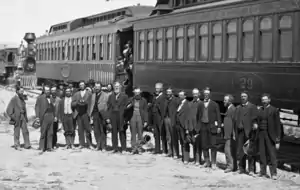Hezekiah Bissell
Hezekiah Bissell (February 27, 1835 - June 23, 1928) was a nineteenth century American railroad engineer, civil engineer, and railroad maintenance of way manager for a number of railroads in the Northeastern United States, including the Cleveland, Cincinnati, Chicago and St. Louis Railway, Eastern Railroad of Massachusetts, and the Boston & Maine.[1]

Bissell was also part of the effort to build the Union Pacific railroad to Promontory Point, Utah in 1869. Bissell was present at the Golden spike ceremony on May 10, 1869, connecting the Central Pacific and Union Pacific railroads at Promontory Summit, Utah Territory. Bissell was also in the Russell and Savage photographs of the same date [2]
Early life and career
Bissell was born on February 7, 1835, at East Windsor, Hartford County, Connecticut [3] to John Bissell (1796-1872) and Elizabeth McKnight Thompson (1800-1887).[4] He was a graduate of the Sheffield Scientific School at Yale College. Bissell first married Alice Hughes (1847-1905) in 1875 and they had three children, Paul Andrews Bissell (1876-1963), John Hughes Bissell (1878-1943) and William Norton Bissell (1878-1977).[4] Alice died in 1905 and Bissell remarried in 1910 to Sigrid Johansen (1878-1918).[3][5]
Civil War
In April 1861, Bissell enlisted in the Union Army [4] as part of the 1st Connecticut Infantry Regiment for ninety days. He re-enlisted in the 25th Connecticut Infantry Regiment in November 1861 as a first lieutenant Company "G" in and saw in Louisiana including the Siege of Port Hudson until it was mustered out of service in 1863.[6]
Post bellum career

Union Pacific Railway Company
Bissell worked as a surveyor on the Union Pacific Railway from 1864–1869, under Ogden Edwards. In 1868 he supervised the construction of the Dale Creek Bridge in southeastern Wyoming, a challenging feat of engineering at that time. The bridge was the highest bridge along the Union Pacific built to cross the chasm between Sherman Summit in the Laramie Mountains west of Cheyenne and the Laramie Plains.[7][8]
Bissell remained with the project until its completion at Promontory Point and the Golden Spike event on May 10, 1869.Bissell was also in the Russell and Savage photographs of the same date [2]
In 1904, Bissell was elected a director of the American Society of Civil Engineers.[9]
Death and interment
Bissell died on June 23, 1928, at Pasadena, Los Angeles County, California. He is interred at Mountain View Cemetery and Mausoleum, Altadena, Los Angeles County, California.[3]
Sources
- Men and women of America: a biographical dictionary of contemporaries. New York City : L.R. Hamersly & Co. 1910.
- Haycox Jr, Ernest. "'A very exclusive party'." Montana; The Magazine of Western History 51.1 (2001): 20.
- Anon. "Hezekiah Bissell". Find-A-Grave. Find-A-Grave. Retrieved 31 July 2020.
- Anon. "Hezekiah Bissell Family Tree". Ancestry.com. Ancestry.com. Retrieved 2 August 2020.
- Pasadena Evening Post; Publication Date: 25/Jun/ 1928; Pasadena, California. Source Ancestry.com
- Dyer, Frederick H. A Compendium of the War of the Rebellion (Des Moines, IA: Dyer Pub. Co.), 1908.
- Ambrose, Stephen E. (2000). Nothing Like It In The World, The Men Who Built The Transcontinental Railroad, 1863-1869. Simon&Schuster. ISBN 0-684-84609-8.
- Williams, John H. (1996). A great and shining road: the epic story of the transcontinental railroad. Lincoln, [Neb.]: University of Nebraska Press. p. 103. ISBN 0-8032-9789-0.
- Engineering news-record, Vol. 52, October 20, 1904. New York: McGraw-Hill